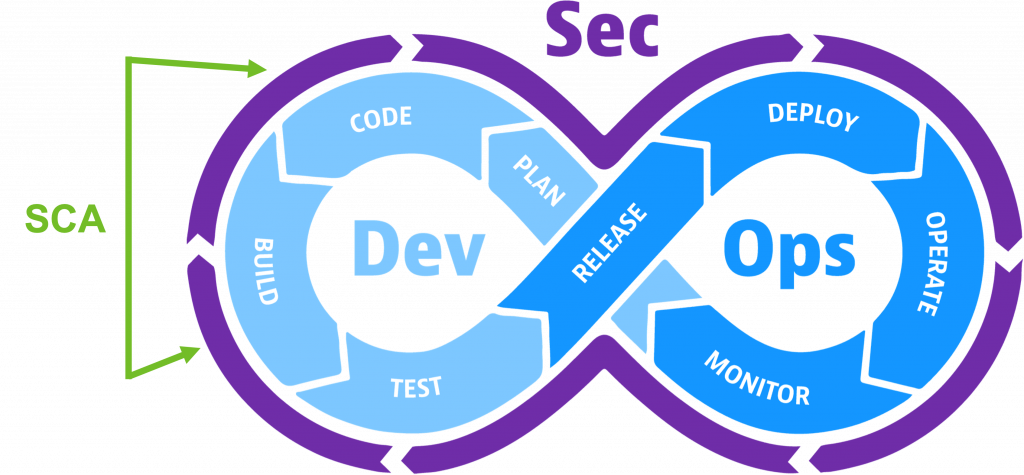The growing popularity of open source software presents new risks associated with vulnerable libraries. In response, organizations have adopted additional security tools, such as software composition analysis, that scan code libraries for vulnerabilities. These tools enable organizations to mitigate risk earlier in the software development lifecycle (SDLC).
Traditionally, companies tracked these vulnerabilities manually or sifted through volumes of code. Both approaches resulted in lost time and resources. To handle the increasing complexity of open source software, software composition analysis (SCA) has become an important tool. SCA scans software dependencies for security vulnerabilities with speed and reliability.
What is software composition analysis?
Software composition analysis is an application security methodology that tracks and analyzes open source software components. Fundamentally, SCA tools provide insight into open source license limitations and possible vulnerabilities in your projects. These tools help organizations stay abreast of critical tasks, including security, license compliance, and code quality, to minimize risk.
Software composition analysis provides three core capabilities:
- Build a software bill of materials (SBOM) to establish a detailed inventory of your open source software packages.
- Verify license compliance requirements by determining what open source software you’re using and where it originated.
- Discover detailed information about key vulnerabilities in your source code and provide applicable remediation suggestions.
How does software composition analysis work?
SCA tools work by running scans on a code base and creating a vulnerability analysis. The analysis outputs an SBOM that lists software components and their respective licenses. In addition, the scan inspects files to find vulnerable third-party libraries and provides insight into open source dependencies. The technology then compares the SBOM with other vulnerability databases to pinpoint critical vulnerabilities. Finally, an SCA tool offers remediation suggestions to resolve harmful vulnerabilities. As part of the process, SCA provides a full analysis of open source project health metrics.
For example, an organization that needs to establish a comprehensive security and compliance baseline can use software composition analysis to attain baseline license compliance and reveal security vulnerabilities. As teams further develop their code, they can use SCA to maintain license compliances and ensure consistent security.
Why is software composition analysis important?
Software composition analysis is an essential practice for IT professionals tasked with securing complex software ecosystems. Modern software development relies heavily on open source components and third-party libraries, which bring efficiency and robustness to the development process. However, they also introduce unique security, compliance, and risk management challenges.
- Identifying vulnerabilities:
Open source components often have inherent vulnerabilities due to their wide usage and public availability of their source code. This makes them attractive targets for bad actors. Without SCA, organizations risk unknowingly deploying software with vulnerabilities and exposing their systems. SCA tools provide automated scans to identify known vulnerabilities in third-party components.
- Ensuring license compliance:
Understanding the legal implications of open source software is critical. Many open source licenses come with obligations that organizations must adhere to—like attribution requirements or restrictions on commercial use. Non-compliance can lead to legal disputes, fines, or even the need to re-engineer software. SCA tools help by automatically flagging license issues, ensuring organizations remain compliant.
- Managing supply chain risks:
Using external dependencies in software increases the likelihood of inheriting risks from upstream sources. Compromised dependencies can ripple through an organization’s entire software stack. SCA offers visibility into an SBOM, enabling teams to monitor which components are in use and quickly address risks when vulnerabilities are discovered.
By embedding SCA into their development and DevSecOps practices, IT professionals can proactively mitigate risks, maintain compliance, and safeguard their software supply chain. SCA isn’t just a tool—it’s a vital part of protecting modern software systems in an increasingly interconnected world.
The benefits of software composition analysis
Software composition analysis (SCA) offers invaluable benefits to developers and IT professionals committed to creating secure, high-quality software.
Enhanced security
One of SCA’s primary advantages is its ability to enhance software application security. SCA tools automatically scan your codebase to identify open source components and check them against known vulnerability databases.
License compliance
Open source components often come with specific licensing requirements that, if not adhered to, can lead to legal and financial repercussions. SCA tools help ensure compliance by analyzing the licenses of all components within your application, providing insights into potential intellectual property risks.
Improved development efficiency
By integrating SCA into the development lifecycle, teams can automate the vulnerability detection and license compliance process, freeing up valuable resources. This allows developers to focus more on building features and less on manual checks or patching insecure components.
Risk mitigation and quality assurance
SCA contributes to the overall quality assurance of software products. Organizations can ensure their applications are secure and reliable by effectively managing the risks associated with open source components.
The challenges of software composition analysis
Despite its advantages, SCA presents several challenges that must be addressed to utilize its full potential effectively.
- Managing the volume of open source components
The exponential growth of open source components in software development has led to a significant challenge in cataloging and managing these components within applications. With thousands of new open source libraries being added daily, SCA tools must possess robust indexing and update capabilities to ensure that they provide accurate and up-to-date information.
- Understanding license compliance
Open source software often comes with complex licensing terms, and noncompliance can lead to legal issues or intellectual property conflicts. Developers and IT professionals must carefully analyze and comply with these licenses, yet navigating the multitude of open source licenses remains daunting. SCA tools must be comprehensive and adept at identifying potential compliance risks.
- Identifying vulnerabilities
A critical function of SCA is the detection of security vulnerabilities within open source components. However, the sheer volume of potential vulnerabilities makes it challenging to prioritize which issues need immediate attention. False positives can divert resources away from actual threats, necessitating an efficient system for triaging alerts.
- Integration with CI/CD pipelines
For SCA to be effective, seamless integration into CI/CD pipelines is needed. The process requires careful planning and execution to ensure that SCA tools provide real-time insights without hindering development velocity.
How to implement SCA in your development pipeline
Understanding SCA
Software composition analysis is a methodical approach to managing open source components within a codebase. It identifies vulnerabilities and licensing issues, providing developers with a comprehensive overview of their software’s security posture.
Key steps in implementing SCA
- Integration into CI/CD pipelines: This allows for real-time monitoring and identification of vulnerabilities as new code is committed.
- Automated scanning and reporting: These tools analyze the codebase for known vulnerabilities against databases and immediately alert developers to potential risks.
- Policy management and governance: SCA tools often provide governance features that allow teams to enforce dependency management policies, ensuring compliance with organizational standards and legal requirements.
- Continuous monitoring and updates: The dynamics of software development mean that vulnerabilities can appear at any time. Continuous monitoring and regular updates to the SCA tool’s vulnerability database guarantee that your security measures stay ahead of emerging threats.
How security can “shift left” in a DevSecOps lifecycle
One of SCA’s major benefits is that security pros can implement it into the initial stages of the SDLC. Teams can test projects for vulnerabilities in the early stages of development before those issues reach the build stage. This saves overall production costs and valuable resources.
Moreover, IT pros can use SCA to gain a better understanding of the open source software the organization uses and to track licenses. Accordingly, SCA tools can streamline the license management process and enforce security and license policies across the different stages of the SDLC.
Finally, SCA tools bridge the gap between detection and remediation by showing the location of vulnerabilities, assessing their impact, and suggesting remediation actions.

But software composition analysis tools alone are not enough
Despite their benefits, SCA tools don’t cover the entire security surface area. For one, SCA tools primarily focus on pre-production environments. This means you’re unable to scan for vulnerabilities exposed in production.
Additionally, although software composition analysis provides remediation suggestions for critical vulnerabilities, it does not prioritize them. As a result, IT pros are left to determine which issue to address first based on the current vulnerabilities and risk priority order. With limited time and resources, it can be difficult for security teams to prioritize vulnerabilities without deeper analysis.
Lastly, SCA tools don’t provide information about which pending issues are the most critical to your business assets. They also provide no context surrounding a vulnerability’s point of origin.
How to pair SCA with runtime application security
Although software composition analysis tools are limited, you can enhance their value by pairing them with another layer of security at runtime.
The Dynatrace Software Intelligence Platform analyzes the full impact and risks of vulnerabilities, in context, at runtime. The Dynatrace Application Security module not only delivers remediation suggestions but also eliminates false positives, prioritizing which critical issues to address first. Dynatrace OneAgent automatically discovers vulnerabilities in both production and pre-production environments, capturing the entire range of possible issues.
By incorporating key contextual information surrounding software vulnerabilities into the Davis Security Score, Dynatrace allows you to filter and prioritize issues to determine which ones your team must remediate immediately. Dynatrace Application Security eliminates blind spots and proactively identifies critical production risks earlier in the process, all to ensure your organization’s SDLC runs seamlessly.
Software composition analysis FAQ
- What is the difference between SCA and SAST?
While both improve software security, SCA analyzes third-party and open source dependencies to find vulnerabilities and licensing information. On the other hand, SAST examines your proprietary code to detect flaws such as insecure coding practices or logic errors.
- What are the benefits of using SCA tools?
SCA tools provide several benefits, including:
- Automatically detecting open source vulnerabilities
- Ensuring compliance with licensing obligations
- Speeding up the identification of security risks in software
- Offering continuous monitoring for newly reported vulnerabilities
- What industries require SCA?
Any industry using open source software can benefit from SCA. However, industries like finance, healthcare, and government, which rely on software for highly sensitive processes, prioritize SCA to reduce security risks.
- How often should I run SCA scans?
SCA scans should be integrated throughout the software development lifecycle. Regular scans during development, testing, and maintenance phases are critical to identifying new risks as they emerge.
- Can SCA help with compliance requirements?
Yes, SCA helps organizations comply with legal standards and regulations, such as GDPR or intellectual property laws, by validating that open source component licenses align with business requirements.
- What is the difference between SCA and DAST?
While SCA examines your software’s dependencies for vulnerabilities, Dynamic Application Security Testing (DAST) tests your application dynamically in a runtime environment to find security weaknesses like injection attacks or misconfigurations.
- What is an SCA vulnerability?
An SCA vulnerability is a recognized weakness in third-party or open source components that attackers could exploit.
- What is “composition” in software testing?
Composition refers to understanding and managing all dependencies (libraries, frameworks, packages) your software relies on. This involves identifying their origin, versions, and known risks.
- What is the purpose of SCA?
The purpose of SCA is security, compliance, and efficiency. It ensures that vulnerabilities in dependencies are mitigated, license risks are addressed, and the software supply chain is safe.
- How to do a SCA analysis?
SCA is typically done using specialized tools. These tools automate scanning your dependencies, mapping them to known vulnerabilities, and providing actionable insights for remediation.
To learn more about how Dynatrace helps eliminate runtime vulnerabilities at all points in production, join us for the on-demand webinar, Intelligent Automation for DevSecOps.





Looking for answers?
Start a new discussion or ask for help in our Q&A forum.
Go to forum